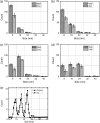A comparison of step-detection methods: how well can you do?
- PMID: 17827239
- PMCID: PMC2134886
- DOI: 10.1529/biophysj.107.110601
A comparison of step-detection methods: how well can you do?
Abstract
Many biological machines function in discrete steps, and detection of such steps can provide insight into the machines' dynamics. It is therefore crucial to develop an automated method to detect steps, and determine how its success is impaired by the significant noise usually present. A number of step detection methods have been used in previous studies, but their robustness and relative success rate have not been evaluated. Here, we compare the performance of four step detection methods on artificial benchmark data (simulating different data acquisition and stepping rates, as well as varying amounts of Gaussian noise). For each of the methods we investigate how to optimize performance both via parameter selection and via prefiltering of the data. While our analysis reveals that many of the tested methods have similar performance when optimized, we find that the method based on a chi-squared optimization procedure is simplest to optimize, and has excellent temporal resolution. Finally, we apply these step detection methods to the question of observed step sizes for cargoes moved by multiple kinesin motors in vitro. We conclude there is strong evidence for sub-8-nm steps of the cargo's center of mass in our multiple motor records.
Figures








Similar articles
-
Kinesin moving through the spotlight: single-motor fluorescence microscopy with submillisecond time resolution.Biophys J. 2007 Apr 1;92(7):2536-45. doi: 10.1529/biophysj.106.093575. Epub 2007 Jan 19. Biophys J. 2007. PMID: 17237204 Free PMC article.
-
Shock detection in dynamics of single-headed motor proteins KIF1A via Jensen-Shannon divergence.Phys Rev E Stat Nonlin Soft Matter Phys. 2011 Oct;84(4 Pt 1):041907. doi: 10.1103/PhysRevE.84.041907. Epub 2011 Oct 5. Phys Rev E Stat Nonlin Soft Matter Phys. 2011. PMID: 22181175
-
Effect of the microtubule-associated protein tau on dynamics of single-headed motor proteins KIF1A.Phys Rev E Stat Nonlin Soft Matter Phys. 2014 Feb;89(2):022714. doi: 10.1103/PhysRevE.89.022714. Epub 2014 Feb 19. Phys Rev E Stat Nonlin Soft Matter Phys. 2014. PMID: 25353516
-
Collective dynamics of interacting molecular motors.Phys Rev Lett. 2006 Jul 21;97(3):038101. doi: 10.1103/PhysRevLett.97.038101. Epub 2006 Jul 19. Phys Rev Lett. 2006. PMID: 16907545 Review.
-
Kinesin: a molecular motor with a spring in its step.Proc Biol Sci. 2002 Nov 22;269(1507):2363-71. doi: 10.1098/rspb.2002.2117. Proc Biol Sci. 2002. PMID: 12495505 Free PMC article. Review.
Cited by
-
Test of normality for integrated change point detection and mixture modeling.J Membr Biol. 2013 Jan;246(1):57-66. doi: 10.1007/s00232-012-9504-9. Epub 2012 Oct 16. J Membr Biol. 2013. PMID: 23070527
-
Quantitative analysis of single-molecule force spectroscopy on folded chromatin fibers.Nucleic Acids Res. 2015 Apr 20;43(7):3578-90. doi: 10.1093/nar/gkv215. Epub 2015 Mar 16. Nucleic Acids Res. 2015. PMID: 25779043 Free PMC article.
-
Label-free detection of single nanoparticles and biological molecules using microtoroid optical resonators.Light Sci Appl. 2016 Jan 1;5(1):e16001. doi: 10.1038/lsa.2016.1. eCollection 2016 Jan. Light Sci Appl. 2016. PMID: 30167109 Free PMC article.
-
Step detection in single-molecule real time trajectories embedded in correlated noise.PLoS One. 2013;8(3):e59279. doi: 10.1371/journal.pone.0059279. Epub 2013 Mar 22. PLoS One. 2013. PMID: 23533612 Free PMC article.
-
Unsupervised Idealization of Ion Channel Recordings by Minimum Description Length: Application to Human PIEZO1-Channels.Front Neuroinform. 2017 Apr 27;11:31. doi: 10.3389/fninf.2017.00031. eCollection 2017. Front Neuroinform. 2017. PMID: 28496407 Free PMC article.
References
-
- Svoboda, K., C. F. Schmidt, B. J. Schnapp, and S. M. Block. 1993. Direct observation of kinesin stepping by optical trapping interferometry. Nature. 365:721–727. - PubMed
-
- Mallik, R., B. C. Carter, S. A. Lex, S. J. King, and S. P. Gross. 2004. Cytoplasmic dynein functions as a gear in response to load. Nature. 427:649–652. - PubMed
-
- Nan, X., P. A. Sims, P. Chen, and X. S. Xie. 2005. Observation of individual microtubule motor steps in living cells with endocytosed quantum dots. J. Phys. Chem. B Condens. Matter Mater. Surf. Interfaces Biophys. 109:24220–24224. - PubMed
Publication types
MeSH terms
Substances
Grants and funding
LinkOut - more resources
Full Text Sources
Other Literature Sources

